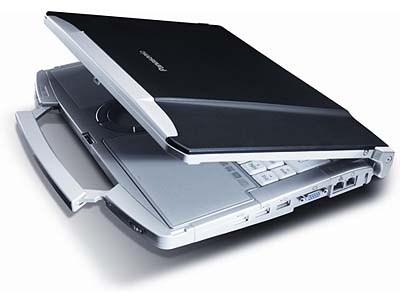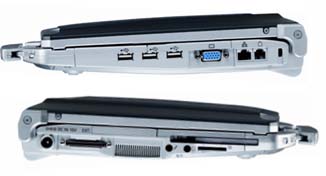On September 25, 2008, Panasonic introduced the Toughbook F8. Since there wasn't an F7 or other predecessor, we suppose Panasonic simply wanted this new machine to fit into the overall nomenclature of its proliferating lineup of ultralights. The F8, however, represents several firsts:
It is the first Panasonic ultralight that has switched from the traditional 4:3 aspect ratio screen format to the increasingly popular 16:10 aspect ratio "wide" format. It is also the first Panasonic ultralight that really looks like a Toughbook as opposed to just carrying the name of Panasonic's line of rugged notebooks. And it is the first ever ultralight Toughbook with an emphasis on serious performance as opposed to limiting itself to the noble task of optimizing battery life.

Given the sterling reputation and characteristic design of Panasonic's rugged machines, it makes perfect sense to extend that look to one of the ultralight series. And since the company already has the T-Series and W-Series (as well as, in Japan, the even tinier R-Series) of light and super-miserly notebooks, it also makes sense to offer one with more punch under the hood. The wide-format display, in all honesty, is an acquired taste and probably more market-driven than entirely necessary.
But let's get to specifics: Panasonic did a terrific job in making the F8 look like a "real" Toughbook, down to the trademark integrated handle pioneered by what is today the Toughbook CF-30 many years ago. This machine is exceedingly handsome and could easily sell on looks alone. However, pick up the new Toughbook F8 and you'll be stunned by how little it weighs. Yes, somehow Panasonic managed to create a machine with a big 14.1-inch screen, an integrated handle, and an integrated optical drive, and it weighs less than four pounds! That's unheard of in a computer that also looks like it's indestructible.

In the engine compartment, the new F8 got the whole Centrino treatment, with a new gen processor, chipset and WiFi module. However, while the F8 is almost ridiculously light and compact, Panasonic gave it a beefy 2.26GHz Intel Core 2 Duo SP9300 processor that should easily outperform most ultralight mobile systems. Since the chip draws a maximum thermal design power of 25 watts, significantly more than the 5-17 watts of low and ultra-low voltage designs (let alone Atom processors), won't that result in low battery life? Not if the machine comes with a battery as powerful as the one in the F8. You still get about six hours between charges.
The wide-format display, as stated above, is a first for a Panasonic ultralight. Its 1280 x 800 resolution is acceptable for almost all work, and Panasonic's anti-reflective treatment is very effective. It'd be nice to have a touchscreen option, but for that Panasonic has other models.
On the storage and memory side of things, we appreciate being able to get as much as 4GB of RAM in a Vista machine. Capacity of the shock-mounted hard disk is 160GB -- good enough. And it's just great to have an integrated Super MULTI dual layer-capable DVD drive in a machine this small and light.
Wireless connectivity has always been one of Panasonic's strong side, and the F8 continues that tradition. Intel's WiFi Link 5100 supports even the speedy new 802.11 draft-n standard, you get Bluetooth v2.0 with enhanced data rate, and you can specify optional integrated Gobi 3G global mobile Internet (WWAN on EV-DO Rev. A and HSPA).
Ultra-lights always cost a bit more, and that applies to the F8's starting list price of US$2,499 as well. However, in this case you truly get an exceptional machine for the money, one that is worth every penny.



